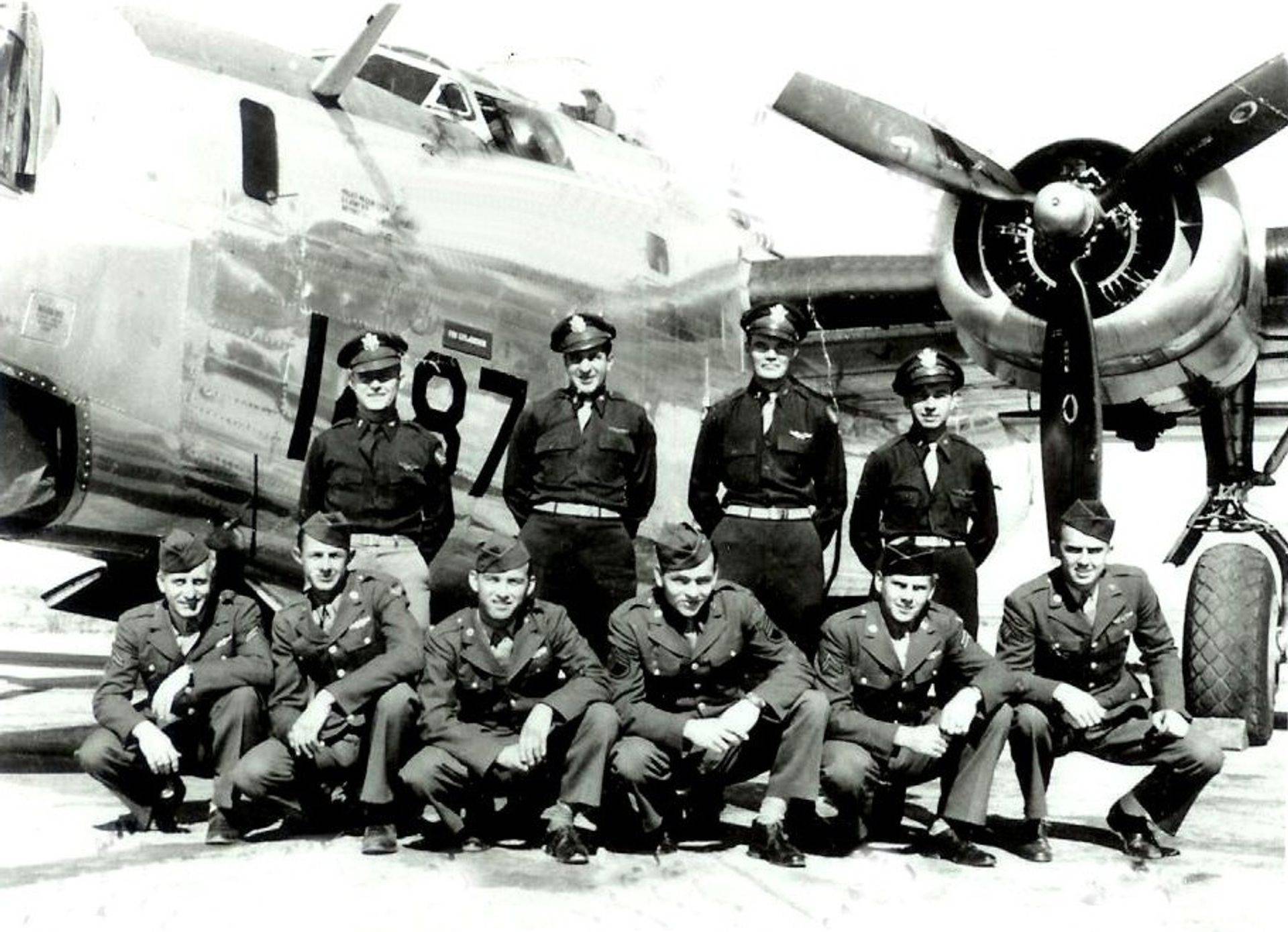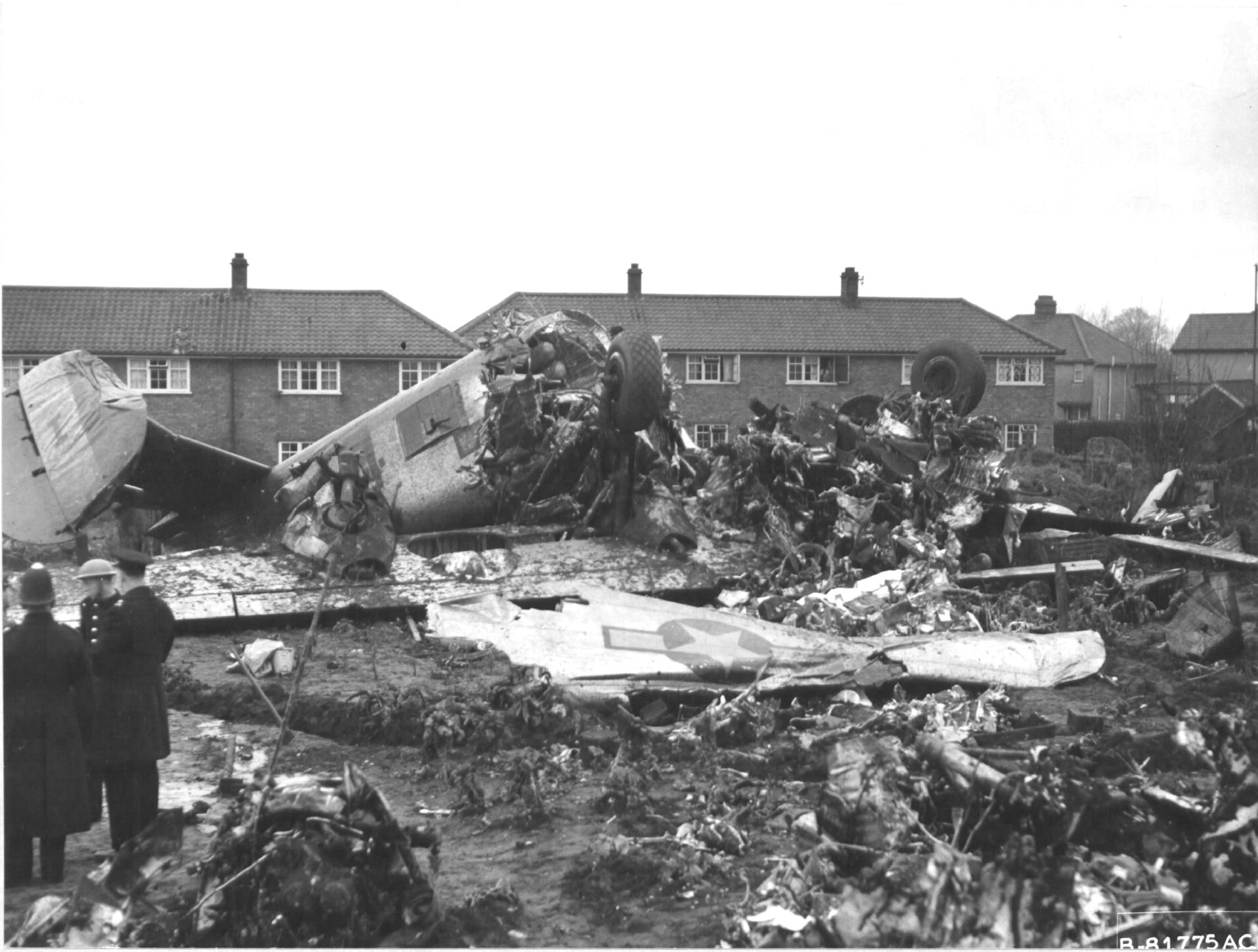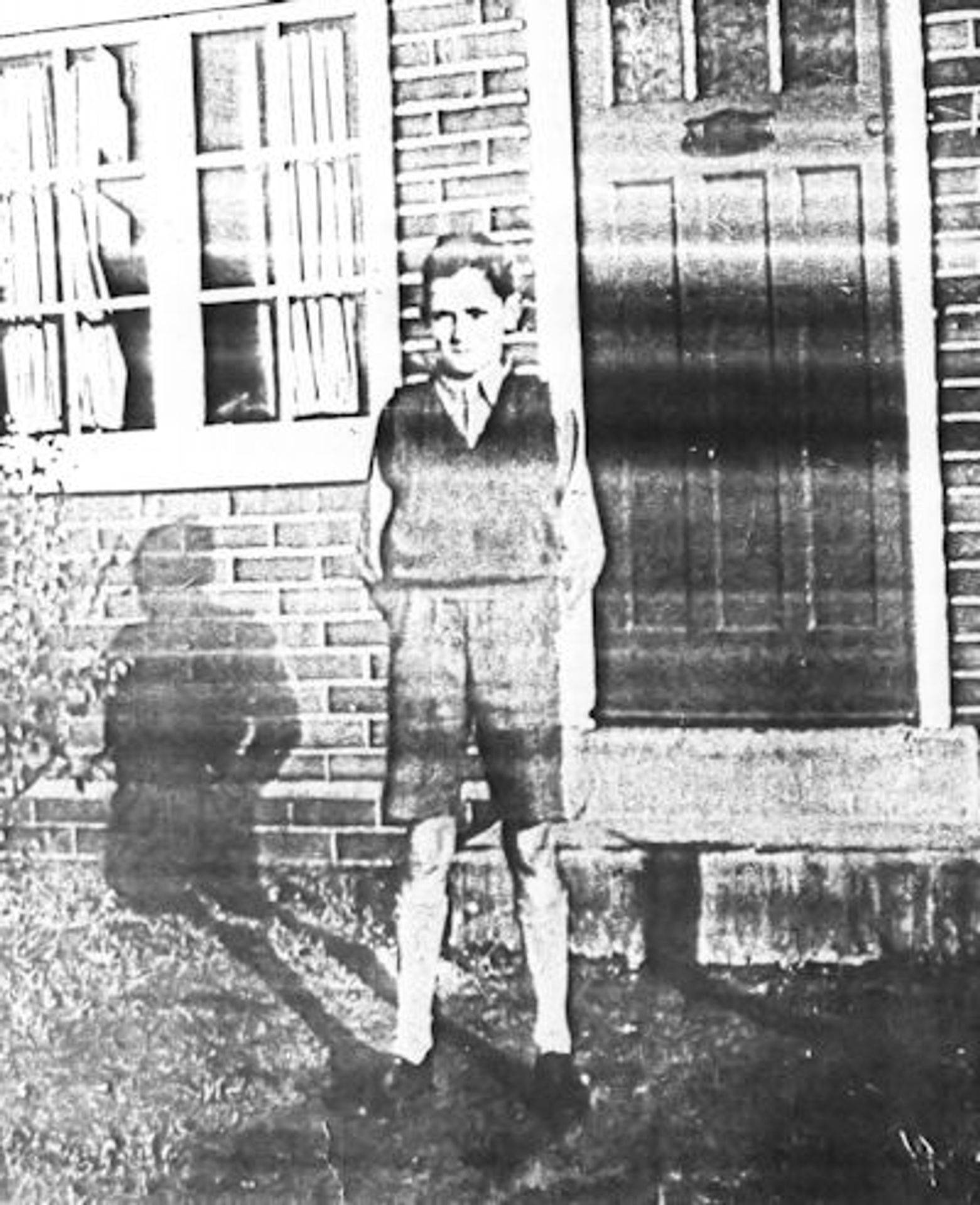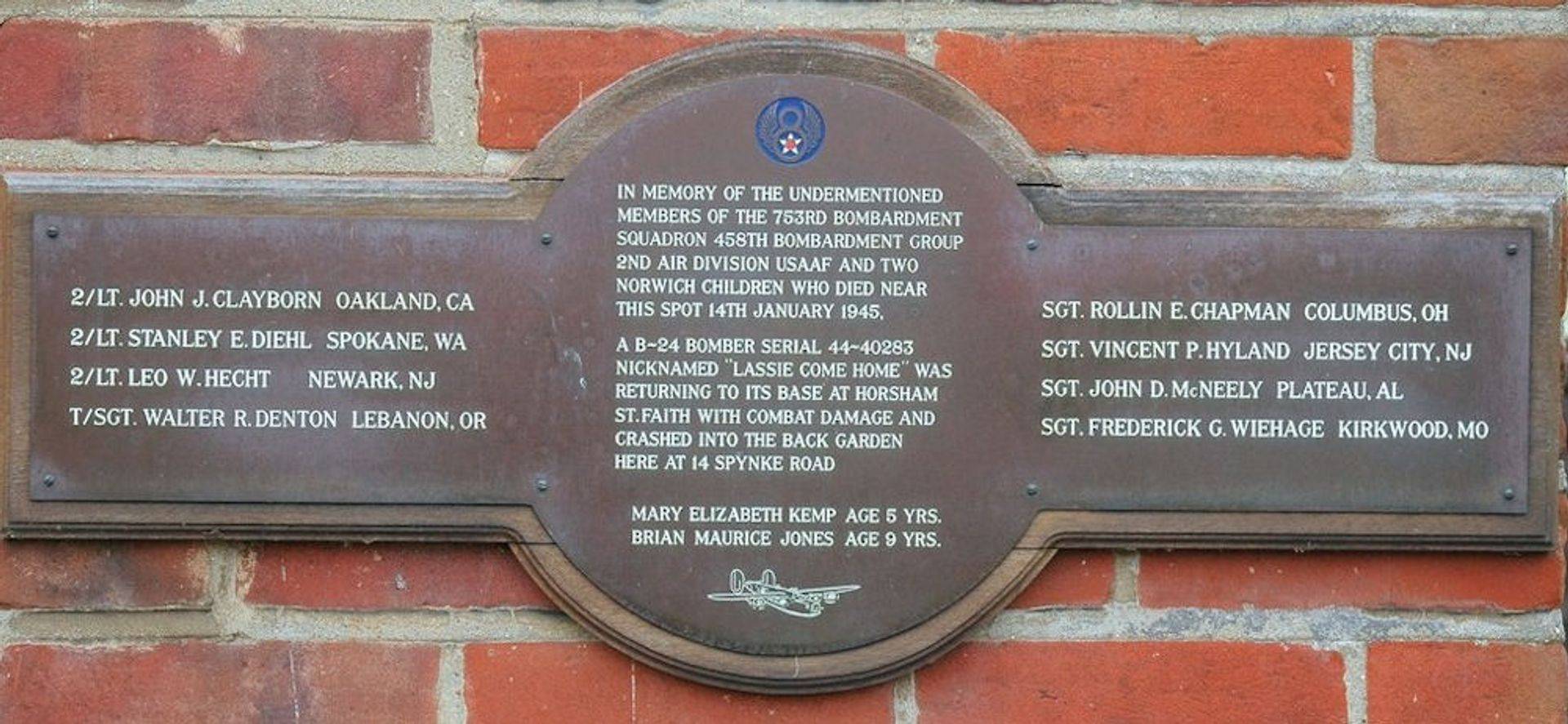Diehl Crew – Assigned 753rd Squadron – November 18, 1944

Kneeling: Vincent Hyland – NTG, John McNeely – WG, Norton Lawson – TG, Walter Denton – E, Fred Wiehage – TTG, Rollin Chapman – RO
Crashed near base due to battle damage – January 14, 1945
| Rank | Name | Serial # | Crew Position | Date | Status | Comments |
|---|---|---|---|---|---|---|
| 2Lt | Stanley E Diehl | 0718579 | Pilot | 14-Jan-45 | KIA | Cambridge American Cemetery |
| 2Lt | Harold W Blanshan | 02063963 | Co-pilot | 01-May-45 | RFS | Air Crew Leave |
| 2Lt | John J Clayborn | 02065134 | Navigator | 14-Jan-45 | KIA | California |
| Sgt | Rollin E Chapman | 35224326 | Radio Operator | 14-Jan-45 | KIA | Cambridge American Cemetery |
| T/Sgt | Walter R Denton | 39320527 | Flight Engineer | 14-Jan-45 | KIA | Linn County, OR |
| Sgt | Vincent P Hyland | 32261418 | Nose Turret Gunner | 14-Jan-45 | KIA | Cambridge American Cemetery |
| Sgt | John D McNeely | 38511715 | Waist Gunner | 14-Jan-45 | KIA | Chicot County, AR |
| Sgt | Frederick G Wiehage | 37619122 | Top Turret Gunner | 14-Jan-45 | KIA | St Louis, MO |
| S/Sgt | Norton A Lawson | 36828769 | Tail Turret Gunner | 15-May-45 | FEH | Reclassified 612 |
Stanley Diehl and crew arrived at Horsham in mid-November 1944 and after a period of indoctrination began flying combat missions at the end of December. Their bombardier, Lt. Echdal was apparently removed from the crew prior to leaving the States, as his name is not on the records assigning them to the group.
On January 13, 1945, on what would have been the crew’s 5th mission, they were forced to abort due to co-pilot Harold Blanshan’s sinus trouble at altitude. It was for this reason that Blanshan did not fly on January 14th. 2Lt Leo Hecht, a newly arrived co-pilot on 2Lt Cecil G. Johnson’s crew took his place. It was Hecht’s first mission. The crew received battle damage over the continent, and with their #1 engine feathered, were attempting to land at Horsham when they lost a second engine on the same side. They crashed into a residential area about one mile south of the base. Two members of the crew survived the crash, Sgt Norton A. Lawson, the crew’s tail gunner, and S/Sgt Robert H. Wehrkamp, a gunnery instructor who had been placed on flying status in December. After a period of recuperation, Sgt Lawson went back to flying. While it is not known how many missions Lawson completed, he is shown flying with Lt Dean G. Williams crew on April 25, 1945, the last mission of the war. Nothing is known of S/Sgt Wehrkamp’s recovery or if he flew any further missions.
S2 Report 14 January 1945:
A/C #283-I crashed approximately one mile south of base upon return from mission. Pilot was making approach with one engine feathered and apparently lost other engine on same side. Category “E”.

A very well written article about the crash site was posted by Stuart McPherson in his blog The Mile Cross Man on February 14, 2018. You can view it here.
Missions
| Date | Target | 458th Msn | Pilot Msn | Serial | RCL | Sqdn | A/C Msn | A/C Name | Comments |
|---|---|---|---|---|---|---|---|---|---|
| 27-Dec-44 | NEUNKIRCHEN | 159 | 1 | 42-50449 | W | J4 | 25 | HEAVENLY HIDEAWAY | |
| 28-Dec-44 | ST. WENDEL | 160 | MSHL | -- | -- | -- | -- | MARSHALLING CHIEF | |
| 30-Dec-44 | NEUWIED | 161 | 2 | 44-40285 | H | J4 | 51 | TABLE STUFF | |
| 03-Jan-45 | NEUNKIRCHEN | 165 | 3 | 42-110163 | M | J4 | 44 | TIME'S A WASTIN | |
| 07-Jan-45 | RASTATT | 166 | MSHL | -- | -- | -- | -- | MARSHALLING CHIEF | |
| 10-Jan-45 | SCHONBERG | 168 | 4 | 42-50449 | W | J4 | 33 | HEAVENLY HIDEAWAY | |
| 13-Jan-45 | KAISERLAUTERN | 169 | ABT | 42-50449 | W | J4 | -- | HEAVENLY HIDEAWAY | CO-PILOT SINUS TROUBLE |
| 14-Jan-45 | HALLENDORF | 170 | 5 | 44-40283 | I | J4 | 30 | LASSIE COME HOME | BATTLE DAMAGE - CRASH |
S/Sgt Henry F. Clayborn
In his search for more complete information on the death of his brother John (navigator), S/Sgt Henry F. Clayborn, U.S Army, on duty in France, obtained leave in March 1945 and made his way to Horsham St. Faith. He received a very warm welcome from the entire 753rd Squadron, especially the two remaining members of his brother’s crew, 2Lt Blanshan and Sgt Lawson. The following is an excerpt from a letter that he wrote to his sister-in-law, John’s widow Cleone.
“After I arrived in England and got myself set up for my stay I located Johnny’s group through the necessary channels and entrained for the closest city to his base. On the last leg of my journey I was fortunate enough to be traveling with one of the enlisted men from his squadron who took me directly to the squadron’s commanding officer. I don’t think that I have ever been treated better in any military installation than I was at the 753rd squadron. There was nothing that they didn’t offer to do for me and any request I made, no matter how tiny, was immediately granted….
“When I finally located the co-pilot, I was treated as if I were his own brother who had come to visit him. You see, the job of writing you the information I’m about to give was going to have to be done by him and I’m sure you realize how hard it would have been to write…. When Blansh heard that I was in the squadron orderly room he rushed up and insisted that I come with him to the combat officer’s quarters and stay with him. The pilot who was his room mate insisted that I use his bed and moved to a vacant one, in spite of any protests I could make. As it was close to supper time we decided to wait until after supper for our talk, at which time Lawson wound get over to Blansh’s room. It’s an army custom to use nicknames for your friends and if I tell you the nicknames of Lawson (Foggy) and Blanshan (Blansh) I can make it a little easier for myself. If Foggy and Blansh are any samples of the crew as a whole it really was a swell crew. From what I learned about each member in particular I would have been proud to have been one of them.
“As we did that night I am going to start my account of the flight itself. It was their “air medal” flight. When a crew completes its sixth mission over enemy territory it receives the air medal and this was the sixth mission. Foggy was the one from whom I got the story of the flight as he alone knew best everything that had happened. Until they were nearing the target everything went along as per routine. Then a flak burst damaged the number one engine on the left hand side seriously so that it was necessary to feather it. In addition the number two engine on that side started to smoke. Diehl was able to keep it going, however, and they were able to resume their position and make their bomb run. After they had unloaded their bombs, of course, they were unable to keep up with their regular formation and were forced to fall back. Eight fighter planes remained with them to provide protection from enemy fighters. The distance to England or Belgium at that time was equal and Diehl took an inter-phone vote among the crew members as to which spot they would head.
“Unanimously they voted to head for England. As they were now flying alone, as far as the bomber formation was concerned, the task of getting them there as fast as possible rested directly on Johnny. He was completely equal to the task. He gave them immediately an ETA (estimated time of arrival) of 3:28 PM at the Coast of England, and exactly at 3:28 they crossed the coast. His job had been done perfectly. Now everyone was relieved because the hardest part had been accomplished. They called the tower for priority landing and were granted the priority and completed the greater part of the circle on the field that is necessary for landing. As they were making the final turn it was necessary to bank into the left side (where the number one engine was feathered) and at the moment they were making the turn the number two engine cut out, leaving the left side completely dead. The force of the two right engines, of course, pushed the plane right over on its back and they crashed into a square of houses bordering the airport. Somehow, in that split second before the crash Diehl must have switched off the engines because there was no fire, although there was a lot of gas in all the tanks. Everyone in the plane was killed except Foggy and an extra gunner who had gone along.
“My greatest fear all along had been that Johnny’s death might have been painful or that perhaps his body had not been recovered. I know now that he died painlessly and that there was not a chance of his body not having been recovered. The reason I know is because Foggy came out of the plane alive and he had moved up near Johnny’s position just before the crash. It happened so fast that none of them except perhaps Diehl could have known what was happening. Foggy said that the only sensation that he could remember was a slight breathlessness like when an elevator goes down and then nothing. Earlier, the other gunner had told me the same thing…. My talk with Foggy and Blansh lasted pretty far into the morning. The combat officers had such nice rooms that you’d darn near think you were back in the States again. The base is about the nicest one I have ever seen overseas and the camaraderie between the officers and men is something the rest of the army would do well to copy…”
B-24JAZ-155-CO 44-40283 J4 I Lassie Come Home



Eyewitness Accounts

On the same day, 14 January, at Horsham St Faith, base staff awaited the return of twenty-eight Liberators dispatched to the Hermann Goering Works at Halle, but Lassie Come Home from the 753rd Squadron never made the base. The pilot, flying only his third mission, was approaching on full flap[s] and had his number one engine feathered and his landing gear down. As he banked into his dead engine he lost a second engine and the aircraft turned over and crashed upside down in the garden of No. 14 Spynke Road, Norwich.Three children were playing in that garden, and Richard Kemp, the sole survivor, recalls the tragedy: “My twin sister Mary and our cousin Brian were playing among the raspberry-canes when I looked up to see that the sky behind my house had turned into metal, all silver-grey with black holes in it and it was coming towards us.
When I opened my eyes I was in Mrs. Copman’s garden and before my nose lay a snake of machine-gun bullets clipped together with loops of metal. Mr Salmon from No. 68 carried me in his arms up our garden path past a big silver tent with two large dustbins outside, a wreath of flames dancing round their tops. I was taken back through our house into a khaki-coloured ambulance. “When I came home from hospital I remember the grown-ups talking about how Mr. Spurgeon was soaked from head to toe in petrol when he looked out of his garden shed to see what was going on; how Mrs. Courtney’s bedroom had been snatched off the corner of her house and her Anderson shelter smashed flat by one of the engines. Later I remember the Vicar’s wife calling with chocolate éclairs, which I never seen before, and the Americans bringing cardboard boxes full of candy, making us sweet millionaires in a ration-book society.”
Earl Zimmerman, who was stationed at Hethel, had cycled over to Spynke Road that day to visit his future wife, June Courtney: “We were sitting round the fire at tea-time when we heard the plane coming over. Suddenly it happened – the sound of engines turning over at high r.p.m., a loud crash as the plane took off the top of our house, and a huge shadow passing by the window. I ran out of the back door and there was a lot of gas all over the place so I ran to all the neighbours telling them to put out all their fires.“The aircraft was such a tangled mess it was difficult to know where to look to find any survivors. About the only recognizable portion was a piece of the fuselage from the waist window to the tail. It was so mangled that I could not get inside, but some neighbours came running over and we eventually managed to get two boys out alive. We laid them out on the front lawn but one of them died. Some people from Horsham St Faith arrived and took the survivor away to hospital. I found out later that he recovered, but never flew again.”
Excerpt from Fields of Little America – Martin W. Bowman

I was one of the children who lived in the house where Lassie Come Home crashed. We had not gone to Sunday school that day as my little sister had been sick in the night. We were playing in the garden when we heard and saw a plane flying low. I was 8 years old and ran toward the house, my sister Mary and her twin brother Dick and also my 12 year old cousin did not make it back. Mary we hope was killed instantly and, Mary was just five. My Dad was coming home from work and saw that a plane would crash but did not know it was on us. My brother remembers waking up and seeing a string of ammo over him, he still finds it very hard to talk about it and seeing the crew brought him to tears.
They brought my sister in and put her on the kitchen table, as a child I could not realize until I had children of my own how grief stricken my parents were.
My sister and I talked at length about this yesterday, she was watching from inside the house and watched the crash, Brian Jones (pictured at right), nine years old, was our cousin who died that day. Her recollection was that Mary was not injured but died from the concussion. We had always thought the navigator also survived, but I guess not. I do remember several years later we found a wedding ring in the garden and my mother returned it to the base.
I since married a GI tail gunner from the Korean war who was sent to England to fly the buffer zone in the Cold War, we have been married 55 years and live in Michigan. We have a twin daughter Mary who is my sister’s namesake. God Bless the families of those brave men who came to save us in WW2. I thank them for their service.
– Margaret Kemp Kinsey
I was eight years old in January 1945, I lived with my mother in a bungalow a few hundred yards from the take-off runway at Horsham St Faith. My father was serving in the Royal Air Force. A school friend and I were watching the returning the B24’s on that day having trembled with excitement and trepidation watching the same bombers clawing into the sky in the morning. We were used to seeing planes with smoking engines, pieces hanging off the various parts of the structure, flares being fired into the sky and a chaff falling down like tinsel. When it seemed like the last hand landed another ship came into sight, I do not recall seeing a propeller feathered or even if the wheels were lowered but it was an all silver coloured aircraft whereas most of the previous B24’s were a drab green even one being all black.
Lassie Come Home seemed to be flying steadily and in a correct attitude that I was completely shocked when I saw the port wing drop and the plane seemed to throw itself head first into the ground. I was with a fellow boy of my own age and after gulping in what had happened he and I made short work of the distance riding our pedal bikes like crazy. We couldn’t miss the giant plane standing on its nose and leaning against a brick dwelling house. It was complete with wings and tail unit in place I recall the engines and the four part of the plane were in-bedded into the ground up to the leading edge of the wing. I am sure there must have been many people there but I didn’t notice them because it was strangely so silent. I expect at my age it was too much to take in and only the crashed plane was of any concern to me. We moved around the edge of the garden and on the pavement was a stretcher covered in a white sheet protruding out of one end were a pair of light brown boots and the other end a large area of blood as we stared at the sad sight we were told in no uncertain way to clear off in good old US dialogue.
For some years it has bothered me as to why the tragedy occurred and whether any of the crew survived. We were unaware of any casualties on the ground as during the war years people didn’t talk much about the war especially to eight year old’s. It is probably of no consolation to anyone now but whoever shut down the fuel switches in the last seconds pilot or co-pilot is all kinds of hero, had there been a fire with fuel and ammunition exploding amongst the close packed houses it would have been a bigger catastrophe than it was already.
– Brian Breeze
Memorial Plaque
Click on pictures for larger images
Courtesy: Robert Maguire


